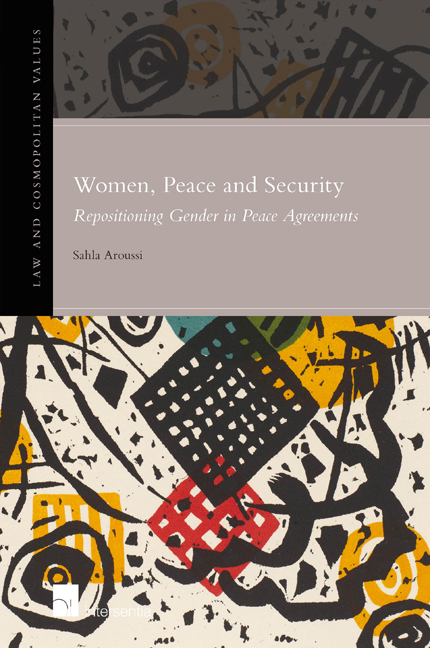Book contents
- Frontmatter
- Acknowledgements
- Contents
- List of Abbreviations
- List of Tables and Figures
- Introduction
- Chapter 1 The United Nations Resolutions on Women, Peace and Security
- Chapter 2 The Gender of Peace Agreements
- Chapter 3 Overview of Gender Provisions in Peace Agreements
- Chapter 4 Women's Political Participation in Peace Agreements
- Chapter 5 Gender-Based Violence
- Chapter 6 Perspectives from the Field
- Conclusion
- References
- Law and Cosmopolitan Values
- Instructions to authors
Chapter 2 - The Gender of Peace Agreements
Published online by Cambridge University Press: 12 December 2017
- Frontmatter
- Acknowledgements
- Contents
- List of Abbreviations
- List of Tables and Figures
- Introduction
- Chapter 1 The United Nations Resolutions on Women, Peace and Security
- Chapter 2 The Gender of Peace Agreements
- Chapter 3 Overview of Gender Provisions in Peace Agreements
- Chapter 4 Women's Political Participation in Peace Agreements
- Chapter 5 Gender-Based Violence
- Chapter 6 Perspectives from the Field
- Conclusion
- References
- Law and Cosmopolitan Values
- Instructions to authors
Summary
THE DEFINITION OF PEACE AGREEMENT
The term ‘peace agreement’ is often used to refer to a variety of documents signed at different stages of a peace process. These include: ceasefire agreements; truce or cessation of hostilities agreements; preliminary agreements; pre-negotiation agreements; framework or substantive agreements; interim agreements; sub-agreements; comprehensive agreements, and implementation agreements. Of course not every peace process includes all of these elements. While some peace processes follow a step-by-step strategy for negotiating and adopting peace accords, others seek to negotiate one main comprehensive agreement. Peace agreements are also signed in very different circumstances. While in some conflicts the parties agree on a ceasefire before entering into substantial peace negotiations, in other cases the cessation of hostilities is left to the final agreement. The negotiation of a peace settlement is usually removed from the conflict zone. For instance, looking at the dataset of peace agreements compiled by this study we see that the Afghanistan (2001) agreement was negotiated in Bonn, Germany; the Uganda (2008) agreements were negotiated in Juba in Southern Sudan; and the Liberia Comprehensive Peace Agreement (2003) was signed in Accra in Ghana.
Bell observes that ‘the act of comparing agreements is immediately open to the challenge that the term peace agreement in fact has no core meaning’. This is why it is imperative at the commencement of this section to clearly articulate the working definition of peace agreements used here. There is no consensus within the scholarly literature on what constitutes a peace agreement. The Uppsala Conflict Data Program (UCDP) states that ‘a peace agreement should address the problem of incompatibility, either by settling all or part of it, or by clearly outlining a process for how the warring parties plan to regulate the incompatibility’. The UCDP divides the incompatibility into government and territory and stipulates that the agreement has to be signed by some of the warring parties and not merely imposed by third parties as is the case with Security Council resolutions. The UCDP also distinguishes between ceasefire agreements and peace agreements, and excludes ceasefire agreements that do not address government and territorial incompatibilities from its definition of peace agreements.
- Type
- Chapter
- Information
- Women, Peace, and SecurityRepositioning gender in peace agreements, pp. 47 - 96Publisher: IntersentiaPrint publication year: 2015

